This is a post I have been wanting to write for a long time, but hesitant to take on. I have done A LOT of work with the professional poultry producers in the past couple years, teaching the best euthanasia techniques and procedures. It is possibly the biggest contribution I will make in my career to animal welfare. I believe that it is part of the responsibility of any animal owner to reduce the suffering of any animal in their care, and euthanasia is an important part of that. I have also been asked by many of you in my comment section for advice, and have seen a LOT of questionable things floating around on the internet.
One thing I will never do is tell an owner WHEN it is appropriate to euthanize. You need to make that decision based on your values, ethics and experience. I have my opinion of whether it is humane to try to set a broken leg on a chicken and try to get her to recover. You have your opinion. Both of our opinions are based on how we compute pain endured vs the value of extending a life. As long as we both consider the situation, and make the decision based on the welfare of the animal, we are both right. Of course, we are both wrong as well. Nobody, regardless of experience, ever euthanizes at the perfect time….we do our best and have to live with the decisions.
Euthanasia definitely does not have to be a “do it yourself” process. Veterinarians will euthanize birds in most cases….often they do not feel comfortable diagnosing or treating, but will still perform this important service. If the cost, distance or circumstances preclude you using a vets’ services, I would far rather see you do the job properly yourself, than botch something as important and emotional as this.
Now, some general information about euthanasia. I consider these facts, and have spent a lot of time and study convincing myself of these truths:
- Euthanasia is an effective tool in improving the welfare of an individual or group of animals
- Euthanasia is more often performed too late, rather than too early. More birds suffer needlessly because their keepers aren’t willing to perform the job than suffer a needless early death.
- Euthanasia is NOT about making a bird dead. The crucial part is making the bird unconscious quickly. I can soak a bird in kerosene, and light it on fire…..it will ALWAYS end up dead, but this is NOT euthanasia. Once a bird cannot feel pain or fear, the method used to kill the body is almost irrelevant, for the bird’s welfare.
- The “appetizing” factor in any method of euthanasia is not relevant to the bird’s welfare. If the bird bleeds, or goes through convulsions, or the act looks violent, the method may still be very humane. The “yuck” factor is an important component of the effect on the “doer”, and this is something to take into consideration, but doesn’t necessarily affect the well-being of the bird.
- Treating an animal with respect will always result in better welfare for both the animal and yourself. If you are doing the best technique you can, and making decisions based on what is best for the bird, you can feel good about what you do.
With these truths in mind, I am going to describe two methods of euthanasia for backyard poultry keepers to consider. They should be appropriate for the vast majority of people who raise chickens on a small scale. I will describe them in gory detail, and will tell you HOW they work, and why they are humane. There are other methods that are humane….I have chosen the most accessible methods that I think will be most useful for small flock owners. If you are squeamish, you may want to stop reading now.
Cervical Dislocation
Cervical dislocation is humane, if done properly. The benefits of this method is that it can be done immediately after identifying that a bird should be euthanized, and needs no tools. It causes unconsciousness in around 40 seconds after being applied, and is very repeatable….that is, it works every time it is done properly. The way cervical dislocation causes unconsciousness is by stretching the neck, dislocating the joint at the base of the skull. This causes the spinal cord (which is very elastic) to snap, and the resulting recoil causes brain damage and unconsciousness through concussion. It causes death by breaking the blood vessels (carotid arteries and jugular veins) so that the brain runs out of oxygen.
Cervical dislocation is NOT effective if the dislocation occurs far down the neck (figure 2), if the neck isn’t stretched lengthwise (“breaking the neck” doesn’t make the bird unconscious….it will die, after several minutes), or if bones are crushed in the process. Spinning the bird (referred to sometimes as the “helicopter” method) is unacceptable, and the “broomstick” method is questionable, depending on technique….if you put too much weight on the broomstick, or stand on it too long, you are causing unnecessary pain and discomfort. The technique that works best, and is recommended by veterinarians and welfare associations is as follows:
- Hold the bird by the legs, tight to your body
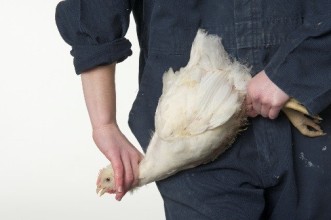
- Grasp the bird by the head, either between the two fingers of the dominant hand, or by the thumb and first finger around the neck
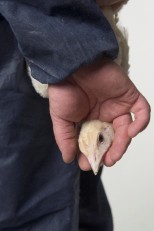
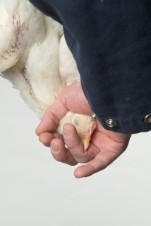
- Tilt the birds head well back, so it points towards the tail of the bird (this position aligns the joints so that it is much easier to dislocate the head from the neck)
- Firmly push the head away from your body until you feel the head separate (you will definitely feel the joint let go)
- Pinch just behind the head to ensure that the head has separated from the neck. You will feel a definite gap, and it will feel like there are 2 layers of skin between your fingers.
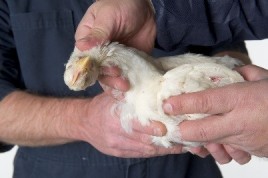
- The bird will convulse and go into spasms….this is normal, and results from the loss of central control over the muscles. The movements do NOT mean the bird is conscious or suffering.
- Always ensure that the euthanasia has been effective by monitoring the bird until after convulsions stop and you can observe lack of breathing and that you cannot hear a heartbeat, either by listening to the chest with a stethoscope (if you have one), or by placing your ear against the birds chest.
Decapitation
Decapitation is an effective, humane method of dispatching a suffering animal. It is NOT instantaneous, but very quick, with unconsciousness usually occurring within 15-20 seconds. Unconsciousness occurs when the head is removed, and the Cerebral Spinal Fluid (CSF) escapes from the cut spinal cord. CSF is a fluid that acts to keep the brain and spinal cord “floating” inside the skull and spine…..by letting this escape, the brain will come in contact with the skull, causing concussion and unconsciousness. Obviously, death will follow because of loss of blood flow to the brain. An important factor in this method is that the head MUST be completely removed. Cutting the major vessels and bleeding the bird out is not humane. Yes….the backyard slaughter method used by many small flock owners is NOT acceptable. If you cut all the blood vessels in the neck, the bird will stay conscious until the oxygen in the brain runs out…..3-4 minutes later. It is called exsanguination (or “bleeding”), and is identified as an UNACCEPTABLE method of killing a bird by the AVMA (American Veterinary Medical Association). If you want to bleed a bird (ie for slaughter), you must make it unconscious first.
Other things to consider when euthanizing via decapitation, are that the blades used must be sharp, and the head must be removed in one cut. The blade, or the scissors must be large enough that one motion completely removes the head. Scissors are helpful as they improve human safety. Axes and knives work very well, but you must be careful! A stump with 2 nails driven in about an inch apart is a good way to hold the head safely, and cutting cones are very helpful to hold the bird still and keep your fingers away from the blade.
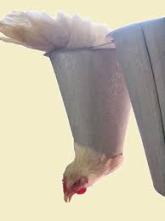
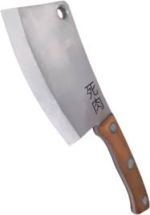
There are other humane methods that can be used, but for various reasons, I don’t think are valuable to describe here. Blunt force trauma is very difficult to do properly, and emotionally disturbing for the person delivering the blow…..the odds of mis-hitting among people who rarely do it are too high for me to recommend it to you. But, in the hands of an experienced, effective operator, this method is extremely humane, despite the violence of the act. Carbon Dioxide gas, captive bolt devices, Low Atmospheric stunning, and electrocution are all humane, and you may hear of them, but need far too much equipment, are often too dangerous and need a lot of training to be done right. Any of these methods, done incorrectly, are inhumane.
Remember….euthanasia is not about making the bird die….it is about how they get there. I’ve heard of backyard poultry people drowning birds, poisoning them, freezing them and other methods that are NOT humane. I choose to believe that they didn’t know of better methods, and hope this article helps.
One last point. Consider what your bird is going through as you are deciding when to euthanize. Remember that chickens hide pain, even severe pain, very well. It’s important to realize that it takes a LOT of discomfort for a bird to stop eating and act sick….hunched up in a corner of a coop. Very often, I feel that more suffering is caused by waiting too long to euthanize than even by people who euthanize incorrectly. It is part of your responsibility as an owner to care for your birds, and if her situation is painful and seems hopeless, it is time to start seriously considering euthanasia.
Mike the Chicken Vet

Wonderful and necessary post Mike. I feel better about this now – that I was at least doing it right on the few occasions I had to. One thing I did notice (the first time I did this against my will/better judgement and I had to do two birds at once) was that the 2nd bird witnessed the first’s demise and that sent (him) into a panic. Not particularly surprising with hindsight but that mistake haunts me to this day.
I’m not sure you should feel haunted Marc. Chickens…..roosters especially, will react violently to a bird flapping….it makes them aggressive and very excited. He may not have been as much frightened as just wound up. I have euthanized birds at the front of a breeder barn before, and suddenly I had a half dozen roosters attacking me and the flapping bird…..I don’t know your situation, but it may not have been as bad for the bird as you thought.
Mike
Thanks Mike. I feel a little better but it was the circumstance that upset me. Being forced to do it against my will. You do give me a little solace though.
This is a brilliant article, Mike. Thank you for the very thoughtful treatment of such a difficult subject. You rock.
Thank you for handling a tough subject with such caring!
Greetings Mike, and thank you for the information. I brew beer and have my own kegging system. I have read the protocol for euthanizing mammals via Carbon Dioxide hypoxia and was wondering if there were any reason this could not be used on poultry. If this would be considered humane, is there any variations to the protocol? Our birds are more pet than livestock and when the time comes, we would like to provide as peaceful a passing as possible for both the individual and the flock. Thanks in advance.
Hi Wiley; I didn’t bring up CO2 because the answer to this is a bit complicated. Putting a bird into 100% CO2 is pretty undomfortable, since the CO2 becomes carbonic acid whenever it touches a moist surface, like the eyes….not too different than getting vinegar thrown in your face. If you add the CO2 in gradually, you can anesthetize the bird before she feels the burn (oddly, it’s not hypoxia that causes the effect….CO2 makes the blood more acidic, which causes the bird to get sedated and then unconscious, then stop breathing). Suffice it to say that it is complicated, and not simple to do well. Is the discomfort of putting a bird in pure CO2 less than that of a bird decapitated or cervically dislocated? I honestly can’t say….that is a decision you have to make. Just know that it is not as peaceful as you might expect….steel yourself for it.
Mike
Great article on a subject no one wants to talk about. Glad you are back.
Thank your for sharing this humane method.!!
Dr Mike,
This article was hard to read, but very well written and necessary. The thought of an animal unnecessarily suffering literally pains me (which is why I am vegan) but I also understand that euthanasia is sometimes necessary. I worry about people doing it wrong, but hopefully this article will help prevent that. I just wish there was a practical way to put all animals to sleep peacefully.
Thank you Dr Mike,
This is one of the most difficult and emotional aspects of keeping animals. Thank you for taking the time to write about it with wisdom, experience and care for both birds and owners. I have had to deal with it a number of times and have two methods. First the axe, very close to the back of the skull, because as you say it causes unconsciousness quicker than any other method. My birds trust me and do not panic, and their end this way is usually peaceful with very little convulsion. The second is by bullet. With a calm bird, placed with the head on the ground and shot through at close range from above in exactly the same location as the axe, where the neck meets the skull. I believe this is as quick and humane, and slightly safer and more accurate than the axe. I would welcome your comments.
Thanks for the kind comment Agnes. As far as I am aware, the placement of the decapitation cut is not crucial….if the head is removed, it doesn’t seem to make a huge difference if it is very close to the skull or not….if it is safer to aim the axe a bit further down, do that. As for gunshot, it is effective, but there is no bullet that will stay inside a birds skull. Be VERY careful what kind of surface you are doing this on. A ricochet can go anywhere and the results can be catastrophic.
The first priority is always for the operator to be safe.
Mike
Indeed, the placement of the bird on the ground and aim down at close range means the bullet goes straight through and into the dirt. Not recommended unless the exit path is carefully planned!
Thank you for this. I’ve got a flock … I haven’t had to yet, but I know I willl need the info. 😀👍🏻
Thank you for this article. I believe that your thoughts on when to euthanize are applicable to other animals we care for as well. I agree with your decision that euthanasia is often utilized too late. Euthanasia is part of responsible animal husbandry and I believe that the greatest gift we can give to animals we care for is a humane end to their life when at all possible.
Thank-you Dr. Mike for doing the research and giving us an answer. We love our hens and don’t want to hurt them! It means a lot to be assured that we’ve dispatched them in the kindest way. I appreciate all the advice you give us on backyard flock care. 🙂🐔
My dad used a method where he put the bird in a cone, and then put a knife into the birds brain through the back of the throat. Instant and very humane I thought. Unfortunately, after 40 years, I’m not comfortable with the how. Do you condone this method and could you give directions if so?
Hi Heather,
I don’t know that your dad’s method is inhumane, but a couple things bother me.
1. To push the knife into the skull takes a bit of a push, and the risk of skewering your hand is worrisome.
2. Depending on the part of the brain you stab, death may not be very quick.
I would suggest using the cone, stretching the neck and decapitating with one stroke….more reliable, and safer. A bird in a cone won’t move very much, and you can minimize the mess by catching the blood in a bucket.
Hope that helps.
Mike
I am sure that others will agree. Your opinions are so appreciated,so needed..Thank you. Every comment ,every answer has been so informative.
Useful article. I have tried the cervical dislocation method, and found i wasn’t strong enough, that was stressful. I use the decapitation method , sharp blade, quick and sure. It is never easy.
Technique is as important as strength. Tilting the head far back, so the bird is looking towards her tail reduces the force needed by a great deal. But absolutely, stick with the method you are most confident and comfortable with.
Mike
Mike,
Just Wanted to say thank you.. read this article because it was shared in a facebook group “maritime Fowl” where I have found a fountain of information. and where culling is discussed but this is a wonderful Post. on humane ways to do it and why. I personally decapitate my fowls, I like the dislocation concept and I may do it one day if me knife isn’t available.
Thank you Again
Mychka
Thank you so much for this informative well written article. I have been anticipating it since you mentioned that you were working on it. I can tell that much thought and caring went into it. I have been ignorantly using the freezer method for newly hatched chicks that you list as inhumane. I’m glad you cleared that up for me.
Thank you for writing this. Many Facebook Backyard Chicken groups forbid talking about euthanasia.
I lost my favorite bird this week. I knew I had to end her suffering, but I didn’t have the money to pay a vet to do it. I gave her 5mg of Lorazepam, one little tablet in each of five kernels of cooked corn. She smelled the corn and snapped her eyes open and gobbled them up, even after refusing anything but dried mealworms for a whole day prior. She refused water as well. I was sure that would put her to sleep, then unconscious, then painless death. It didn’t. She just got high AF. Her pupils were so big, there was almost no ring around them. She woke up, rallied, drank some water and ate a little feed. I kept her inside with me in a basket. The next morning a cold snap broke and we had 60° and sunny. I put her out on the deck in the sun and she slowly walked around chatting with her sisters who had come up to the deck. She laid down, and at first I thought, oh, now she’s dying. Nope. Sun bathing. I put water and food on the deck and she stayed there that day. At twilight I brought her in and out her back in the basket. She slept through the night and in the morning she wouldn’t open her eyes. I called the only vet in town that would treat a chicken and left a message asking if he’d euthanize. She died that night. He CMB the next morning and said he would euthanize when/if I needed it. So. 5mg of Lorazepam won’t euthanize a chicken.
That seems to echo the results in humans oddly enough. For all they are exceptionally addictive, even fairly massive doses of benzodiazepines are rarely fatal on their own. They work on the GABA neurotransmitter in humans but only Mike would know how that affects and avian brain! Sounds like a similar effect – I’d love to know.
I used this procedure today for the first time. I was afraid I didn’t have enough strength to do it right (I am 62 years old and petite) but it was amazingly easy. (not emotionally, but physically) Thank you so much for this detailed post on how to do this humanely.
Marc, in the past I tried ambien. That doesn’t work on chickens either
I can’t imagine. Seems hard to OD on stuff that affects GABA.
Thankfully we have Doctor Mike and his willingness to share his knowledge. I know what you mean about the emotion, I posted about it further up the page. Mike made me fell better, but it’s only something I do out of necessity and my first thought it always with my animals.
I find it ironic that the people who make the most noise about how cruel we are are the ones least aware of how much we care!
Thank you, Dr. Mike. Your thoughts and skill-sharing are invaluable for the committed, backyard peafowl and chicken owner who is also an Incompetent Technician when it comes to ending the life of a beloved pet. Luckily I can call on an outstanding vet here in the Lower Mainland of BC to help me with euthanizing my birds. Yet I do understand that as a bird owner I should have the humane skill of killing my own bird should an unfortunate circumstance present itself. I appreciate your work with chicken farm operations on a commercial level. I try to educate myself (videos, news reports, published info sheets, magazine articles, discussions with workers, etc) on the processes within and would be horrified to enter these farms based on what I have learned. Yet I agree that misinformation is rampant and I applaud your effort to inform us of your experiences. Hopefully one day within this new decade, we will see tremendous change in the attitudes and practice of those who process farm animals. I am speaking specifically on the conditions that animals are kept, the food that they consume and the manner in which they are killed. Important information for the back-yarder is
not that easy to find; your blog is invaluable. I would welcome any initiative on the part of the veterinarian community to specialize on education for the chicken, peafowl and turkey pet owners. It’s a growing collection of humans who want to take compassionate, effective and stress-free environments for their birds. Reading the aforementioned comments from other readers, you are hitting the nail on the head. Thanks so much. I look forward to reading more. Lucky me to have found your blog. Sincerely, Susan Gorris in Aldergrove, BC
Hi Susan, thanks for the support. I would challenge you to make sure you are seeing commercial poultry as it actually is, rather than negative (or positive) propaganda. I am working on developing both a course for backyarders and interested vets. Yet another project delayed by COVID.
I am so very grateful for this article. We have salmonella-infected pine siskins arriving in our yard. I performed a cervical dislocation on one just a bit ago. This article gave me the confidence to handle the situation calmly and humanely.
CO2 is uncomfortable. What about an atmosphere of Nitrogen, or Nitrous Oxide? Both should render the bird unconscious within a minute w/o the CO2 burn if I am correct? Id think Helium might work as well?, or Argon (welding supplies)?
Thanks for a good article. This is knowledge that every responsible chicken owner really needs to know but most want to refuse to learn.
If CO2 is applied properly, there is no burn. It’s also improved upon nitrogen or helium in that it acts as a sedative and anesthetic. The only way nitrogen or argon work, is to displace all the oxygen in the environment, where CO2 at a low concentration puts the bird into deep enough sedation that she stops breathing. Trying to fill and maintain a space to 95 to 98% helium or nitrogen is technically very difficult, whereas getting a concentration of CO2 up to 40% is much easier and more predictable.